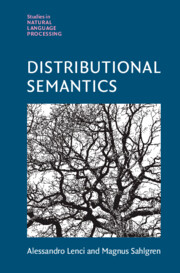
-
Select format
-
- Publisher:
- Cambridge University Press
- Publication date:
- 07 September 2023
- 21 September 2023
- ISBN:
- 9780511783692
- 9781107004290
- Dimensions:
- (229 x 152 mm)
- Weight & Pages:
- 0.79kg, 448 Pages
- Dimensions:
- Weight & Pages:
You may already have access via personal or institutional login
Book description
Distributional semantics develops theories and methods to represent the meaning of natural language expressions, with vectors encoding their statistical distribution in linguistic contexts. It is at once a theoretical model to express meaning, a practical methodology to construct semantic representations, a computational framework for acquiring meaning from language data, and a cognitive hypothesis about the role of language usage in shaping meaning. This book aims to build a common understanding of the theoretical and methodological foundations of distributional semantics. Beginning with its historical origins, the text exemplifies how the distributional approach is implemented in distributional semantic models. The main types of computational models, including modern deep learning ones, are described and evaluated, demonstrating how various types of semantic issues are addressed by those models. Open problems and challenges are also analyzed. Students and researchers in natural language processing, artificial intelligence, and cognitive science will appreciate this book.
Reviews
‘Lenci and Sahlgren's textbook is a landmark contribution to the fast growing and increasingly important discipline of distributional semantics. They have managed to distill 60 years of diverse research on distributional semantics, from its beginning in structural and corpus linguistics and psychology, through the application of techniques from information retrieval and linear algebra, to the most recent developments driven by deep neural networks and large language models in NLP. The authors synthesize the major findings from different fields and integrate these diverse traditions into a comprehensive and coherent framework of distributional meaning. Lenci and Sahlgren's text promises to be the new standard for reference and teaching in this area.'
James Pustejovsky - Brandeis University
‘It is a significant contribution to both linguistic theory and computational linguistics in its own right, providing a bridge between semantic theories and practical applications in natural language processing (NLP). As both a linguist and computational linguist, I found this book relevant to current computational as well as formal semantic research, which increasingly employs distributional methods to understand and model language meaning … Lenci and Sahlgren's book is important, as it presents an impressive treatment of the historical and theoretical foundations of distributional semantics … By providing a clear and rigorous account of how meaning can be modeled through usage patterns, Lenci and Sahlgren contribute to ongoing debates in semantics and cognitive science dating back 70 years. Their book supports the view that meaning in language can be understood through its distributional properties, which can in turn help linguists better understand the formal properties inherent in language meaning.’
James Pustejovsky Source: WORD
‘With this book, Lenci and Sahlgren promote the dissemination of distributional semantics. These studies contribute, on the one hand, to establishing contact with other theories of meaning representation and, on the other, to comparing them with existing ones. This enriches the landscape of semantics and helps us better understand it, as it offers different perspectives for approaching the subject in question. The growing relevance of NLP and AI today finds perfect application in these theories, which serves to confirm the natural progress of semantic theories.’
Paloma Sánchez Hernández Source: International Journal of Ibero-American Linguistics
Contents
Metrics
Altmetric attention score
Full text views
Full text views help Loading metrics...
Loading metrics...
* Views captured on Cambridge Core between #date#. This data will be updated every 24 hours.
Usage data cannot currently be displayed.
Accessibility standard: Unknown
Why this information is here
This section outlines the accessibility features of this content - including support for screen readers, full keyboard navigation and high-contrast display options. This may not be relevant for you.
Accessibility Information
Accessibility compliance for the PDF of this book is currently unknown and may be updated in the future.


